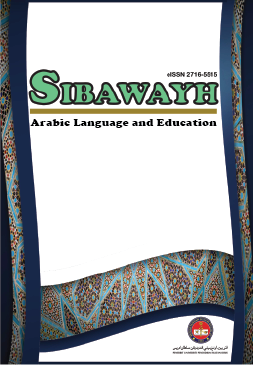تطبيق تعليم ترجمة وعلاقته بتعليم حفظ القرآن وفهمه (دراسة الحالة بمعهد حفظ القرآن مصباح النور جيماحي- إندونيسيا)
Application of Teaching Translation and its Relationship to Teaching Memorize Qur’an (Case study at Ma’had Tahfidzul Qur’an Misbahul-nur Cimahi - Indonesia)
DOI:
https://doi.org/10.37134/sibawayh.vol1.2.2.2020Keywords:
at-ta’liimu, at-tarjamatu, tahfidzul quranAbstract
The language of the Qur’an is Arabic. as the word of Allah subhanahu wataala: "And we sent down the Qur’an with Arabic" (Taha 20: 113). Therefore, the teaching of memorizing the Qur'an is closely related to students' understanding of Arabic. The way to do this for students who memorize the Qur’an, must use appropriate learning methods. One of them is learning the translation of the Qur’an. The purpose of this study, to determine the application of teaching translation of the Qur'an in improving the memorization of the Qur’an for students. Ma'had "Misbahul Nur" Cimahi Indonesia has been serving students in memorizing the Qur'an since 2010. Ma'had "Misbahul Nur" has used the translation method of memorizing the Qur'an in teaching memorizing the Qur'an. The approach used is a qualitative approach of a case study strategy, that descriptive research method is a method of finding a group of people, an object, a group of countries, and ways of thinking or one of the events in the present. The purpose of quality research is to provide a clear picture of the methodology who are realistic, accurate about the facts, and related to the research problem. From this research it's known that the application of teaching translation of the Qur'an does not conflict with the teaching memorize of the Qur'an even very helpful for memorizing the Qur'an. This can be seen from the results of students memorizing the Quran which shows an increase. Besides that it also helps students to understand the vocabulary contained in the Qur'an. Therefore, there is a relationship between teaching the translation of the Qur'an and teaching to memorize the Qur'an in order to understand students about the Qur'an in terms of meaning and content, especially at the ma'had Tahfidzul Qur'an, Misbahul Nur, who has used this method.
Downloads
References
An-Nuqah, M. K. (1983). Ta’limul lugoh Al-Arabiyah (9th ed.). Makkah: جامعة أم القرى.
Ariffin, S., Abdullah, M., Sulaiman, I., Ahmad, K., Deraman, F., Ahmad Shah, F., & Mohd Nor, M. R. (2013). Effective techniques of memorizing the quran: A study at Madrasah tahfiz Al-quran, Terengganu, Malaysia. Middle-East Journal of Scientific Research, 1(13), 45–48.
https://doi.org/10.5829/idosi.mejsr.2013.13.1.1762
Azahari, L. M. (2015). Incorporating Quran Translations into Teaching English to Muslim Learners. Procedia - Social and Behavioral Sciences, 00(00), 3.
Baajumah, A. S. (2009). حفظ القرآن أول مراتب الطلب. Retrieved 8 May 2020, from
https://www.alukah.net/sharia/0/6790
El-Dahdah, A. (1981). A Dictionary of Arabic Grammer in Charts n Tabels (1st ed.). Beirut: Maktabah Lebanon.
Jia, H. (2018). Roman Jakobson ’ s Triadic Division of Translation Revisited Roman Jakobson ’ s Triadic Division of Translation Revisited. Chinese Semiotic Studies, 13(1), 31–46.
https://doi.org/10.1515/css-2017-0003
Khafidah, W., Wildanizar, Tabrani, Nurhayati, & Raden, Z. (2020). The Application Of Wahdah Method In Memorizing The Qur’an For Students Of Smpn 1 Unggul Sukamakmur. IJIEP: International Journal of Islamic Educational Psychology, 1(1), 37–50. Retrieved from
https://journal.umy.ac.id/index.php/ijiep/article/view/8517/pdf_3
Masqon, D. (2006). AL-Lughotul Al-Arabiyyah wa Dawuruha al-Fuaalu fii Syiaghotil Harakaati al-Ilmiyah. Ats-Tasqafah, 2(5), 346.
Nasution, S. (2015). Makna-makna Harfu jar dan Terjemahnya. Retrieved 5 August 2020, from
http://pbaftiainsu.ac.id
Nesrine, G. (2015). Language Transfer: The role of L1 in Learning L2. Fiitardjama, 02(12), 164–174.
https://doi.org/2353-0073
Nurasriyah, L. M. (2014). Tatbiq ‘Paikem’ fi ta’liim allugh al Arabiah lil Talamidi al-Muaqi. Universitas Pendidikan Indonesia.
Nuun wal Qolam. (2010). Universitas Islam Negeri Sunan Ampel, 7.
Sciences, H., & Hicham, A. (2014). What Is Translation ? In Moroccan Short Stories : a Translation (pp. 1–45). Cadi Ayyad University.
Shatibi, A. (2020). The importance of Arabic rhetoric in the interpretation of the Qur’an. SIBAWAYH, Journal of Arabic Language and Education, 1(1), 93–117. Retrieved from
https://ejournal.upsi.edu.my/index.php/SIBAWAYH/article/view/3754/2468
Sichani, S. K., & Hadian, B. (2017). Translation and Critical Discourse Analysis: Contribution of Applying CDA in Analysis of Translated Texts. Journal of Applied Linguistics and Language Research, 4(8), 88–99. Retrieved from
https://www.jallr.com/index.php/JALLR
Zakariya, A. (2006). AL-Muyasar fii I’lmi an-Nahwi. Garut: Ibn Azka Press.
Zohra, E. F. (2017). Translation and Language Teaching in Higher Education: Shortcomings and Implications. El Ishsas, 8, 61–71.
قاموس و معلم الأساسية في الطريق تعليم اللغة العربية. (n.d.) (p. 12).





